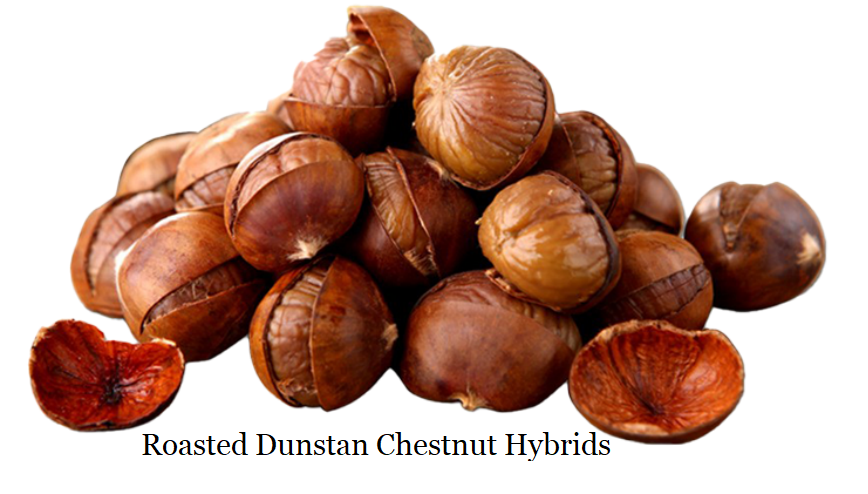Lorem ipsum dolor sit amet, consectetur adipiscing elit. Ut elit tellus, luctus nec ullamcorper mattis, pulvinar dapibus leo.

The Whole Dunstan Hybrid Chestnut Tree Story in a ‘Nutshell’

Dr. Robert T Dunstan was a professor of Romance languages, of all things, at North Carolina’s Greensboro College from the late 1920s to the early 1960s. Perhaps more importantly he was an amateur plant breeder, his passion was creating hybrids.
By the late 1940s, the chestnut blight had killed nearly every native tree in the United States and to make a really long story very short, in the early 1950s, James Carpentar of Salem, Ohio, discovered (during a pheasant-hunting trip) a large living American chestnut in a grove of dead and dying American chestnut trees—the surviving tree likely contained a natural genetic mutation that enabled it to survive.
Some folks say by chance, Mr. Carpentar had previously developed a friendship with Dr. Dunstan in faraway Greensboro, NC who had become a well-known plant breeder. The friendship was likely helped a bit since both were members of the Northern Nut Growers Association.
At any rate, a few years after his ‘find’ Mr. Carpentar shipped some of the “magical” budwood (short lengths of young branches with buds prepared for grafting) to Dr. Dunstan. He grafted the cuttings of budwood onto Chinese chestnut root-stock of which he groomed to the flowering stage, harvested the seed, grew those seeds to maturity and then playing “pollinator” he back-crossed those trees to Chinese-American chestnut tree parents. The result: Dr. Dunstan created in Greensboro, NC, the 2nd generation of blight-resistant Dunstan Chestnut trees in 1962.
In 1963, Dunstan retired and moved with his wife to Alachua, Florida to be near their daughter Aurelia and her husband, Alvin Wallace, who became the head of agricultural research at the University of Florida at Gainesville.
When Dunstan left Greensboro, he took some of his hybrid chestnut seedlings which he re-planted in Florida. As a result, Dr. Dunstan’s “hobby” soon caught the undivided attention of his grandson Bob, son of Aurelia & Alvin Wallace.
By 1981 Bob Wallace’s interest was near its peak so he started the Chestnut Hill Nursery in Alachua, FL at the age of 25.
By 1984 grafts from the best of the second generation trees led to a third generation of Dunstan Chestnut seedling, many of which are now (2025) over 50′ tall and 16-20″ in diameter.
As for Bob’s business, it’s still blooming, with 500 producing 2nd & 3rd generation Dunstan chestnut trees at last count.
______________________ ↓ ____________________
Here’s a more specific breakdown:
Taste: Dunstan chestnuts are often described as having a sweet taste, similar to the American chestnut.
Peeling: Dunstan chestnuts are known for their easy peeling, unlike some imported chestnuts that have clinging seed coats.
Disease Resistance: Dunstan chestnuts are resistant to chestnut blight; the disease that decimated the American chestnut populations during the first half of the 1900’s.
Nut Production: Dunstan chestnuts produce heavy annual crops of large, sweet-tasting nuts.
Life Span: American Chestnut tree-400 to 600 years
Chinese Chestnut tree-50 to 100 years
Dunstan Hybrid Chestnut tree-700 to 800 years
Reproduction: You’d think a few Hybrid Dunstan Chestnut trees in the “wild” would reproduce readily from the abundant crop of nuts they produce each year. Each shiny nut grows in a spiky casing. The casing falls to the ground and splits as the nut matures, releasing the nut. All true, though the jury is most likely still out. As Dunstan advocates insist the tree will do great in the wild, yet according to the American Chestnut Foundation, the Dunstan hybrid trees will not be able to compete with the large shade canopies of the native trees in today’s eastern US woodlands.
Sooo, if you’re planting in the the ‘Wild’, direct seeding is the best way to ensure chestnut tree propagation.
A few additional known Attributes & Facts:
The Dunstan American Hybrid Chestnut nut is generally larger than the competition, averaging 15-35 nuts to equal 1 pound, as compared to Chinese chestnuts (35 to 100 nuts = 1 pound) and American chestnuts of the 1800’s era (50-150 nuts = 1 pound).
Further the Dunstan Chestnut is said to be much better tasting than imported European nuts and are never bland or bitter. Many find them to taste better than American chestnuts as well as having a superior flavor and sweetness when compared to Chinese chestnuts.
And finally, most folks are surprised to learn that the original 1800s era Chestnut tree exists in pockets in the blight-free West, a least where the habitat was agreeable for planting. You see, settlers took seeds with them during the 19th century’s western migration. For example, huge planted chestnut trees can be found in Sherwood, Oregon!
______________________________________________________________
Can You Imagine That